Some years ago, I found at a flea market in Southern Spain collectors cards from the 1930s and 1940s. I liked the hand-coloured or painted images of the American, French, and German stars of the era, but especially the ones of the Spanish actors, who were mostly unknown to me. These thin cards were all printed by the firm of I.G. Vilado in Barcelona and most of them also contain a large sign, Cifesa. I did a little research in this terra incognita.
Cifesa was the most important Spanish film production company and film distributor of the Franco era, and the only one that attempted to function as a traditional Hollywood studio. Among the stars of the studio were Luis Pena, Sara Montiel, Fernando Rey, Jorge Mistral, and the immensely popular Imperio Argentina. Cifesa sponsored lavish public premieres for selected films and created these star cards.
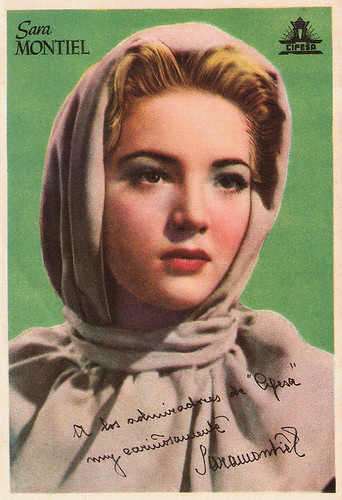
Sara Montiel. Spanish collectors card by I.G. Viladot, Barcelona. Image: Cifesa.

Alida Valli. Spanish collectors card by I.G. Viladot, Barcelona. Image: Cifesa.
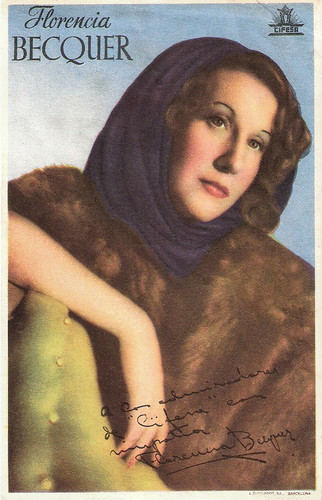
Florencia Becquer. Spanish collectors card by I.G. Viladot, Barcelona. Image: Cifesa.

Luisa Ferida. Spanish collectors card by I.G. Viladot, Barcelona. Image: Cifesa.
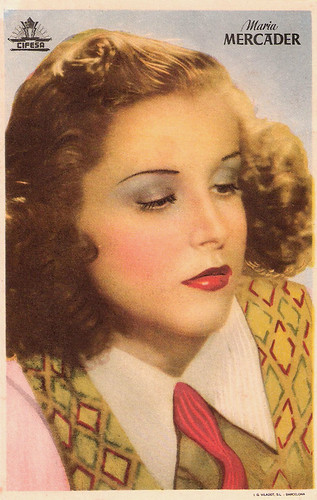
Maria Mercader. Spanish collectors card by I.G. Viladot, Barcelona. Image: Cifesa.
Cifesa, anacronym for Compania Industrial Film Espanola, was founded by Vicente Trenor in Valencia in 1932.
Soon it was soon taken over by an olive oil industrialist, Vicente Casanova, whose son had shown interest in the cinema. From 1933, the company turned out a series of well-crafted, expensive costume pictures and musicals directed by established figures like Benito Perojo and Florián Rey, and acquired a solid reputation among audiences.
Cifesa's motto was ‘The torch of hits’; creating a logo and a house style, as well as nurturing a compact group of stars, was an important lesson Casanova learned from Hollywood.
Ideologically, the Casanova family were conservative Republicans, but after the Civil War, the company pledged allegiance to the Franco regime. This was a perfect collaboration, as the studio was used for propaganda purposes and benefited from a series of privileges.
From 1942 on, against a background of absolute poverty in a country that would take two decades to recover from the conflict, Casanova was back in business producing a series of war films, melodramas, and comedies that created their own version of reality and refused to engage with social issues.
The studio-like aspects of the company were reinforced: soundstages and a company of actors (for instance Amparo Rivelles, Alfredo Mayo, and, later, Aurora Bautista) and technicians, and a certain consistency in tone and approaches due to the presence of strong directors (like Juan de Orduña and José Luis Sáenz de Heredia) who undertook their projects following general programs and guidelines and the firm grip of the head of the production Luis Lucia.
The general production standards were as high as the times allowed, but the emphasis was on high turnout rather than expensive individual films.

David Niven. Spanish collectors card by I.G. Viladot, Barcelona. Image: Cifesa.

Amedeo Nazzari. Spanish collectors card by I.G. Viladot, Barcelona. Image: Cifesa.
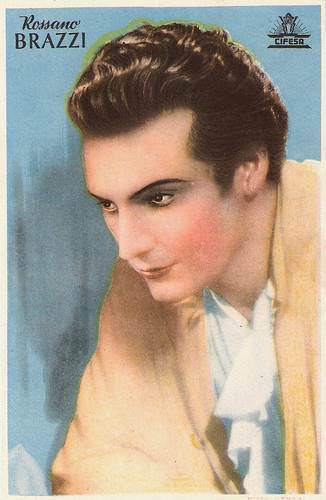
Rossano Brazzi. Spanish collectors card by I.G. Viladot, Barcelona. Image: Cifesa.
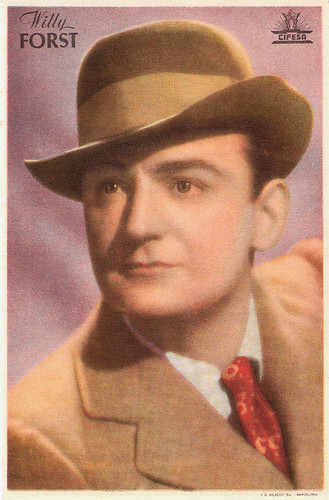
Willi Forst. Spanish collectors card by I.G. Viladot, Barcelona. Image: Cifesa.
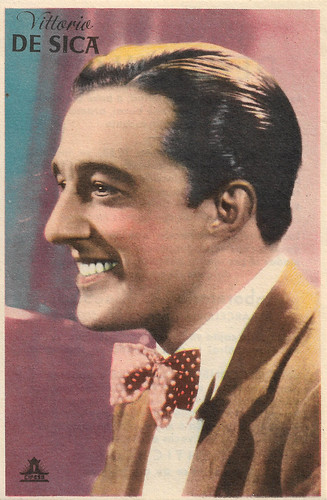
Vittorio De Sica. Spanish collectors card by I.G. Viladot, Barcelona. Image: Cifesa.
The end of World War II was a blow to the Franco government, which was plunged into a situation of complete isolation as the last remnant in Europe of Fascist ideologies. But rather than compromise and benefit from the reconstruction measures introduced by the Allies, the regime decided to strengthen conservatism.
The crisis this led to was reflected in the film business. The government redesigned the system of funding cultural expression - as long as it was the 'right' one. An important aspect was the introduction of a category of special support to those films that could uphold the regime's conservative values.
Casanova responded with a series of lavish historical epics. The company's strategy shifted now to focus on a small number of expensive pictures every year, which would not only be awarded 'special interest' funding but could also turn good profits at the box office.
In the beginning, the strategy seemed to work, with Locura de amor/Mad for Love (Juan De Orduña, 1948) and, later, Agustina de Aragón (Juan de Orduña, 1950), quickly becoming box-office hits.
But investment in each picture was so high that disappointing box-office takings could easily have an impact on the company's finances. This is exactly what happened with La leona de castilla/Lioness of Castille (Juan de Orduña, 1951).
When one of Cifesa's most expensive production efforts, an epic about Christopher Columbus' first expedition titled Alba de América/Dawn of America (Juan de Orduña, 1951), failed to get special interest funding because politicians decided to support José Antonio Nieves Conde's realistic Surcos/Burrows (1951) instead; and when the film only did average business, the company was back in the red, and this time it was unable to regain its previous prowess.
By 1952, the financial crisis deepened, and after a run of poor films, Cifesa disappeared as a film production company in 1956. As a distributor, Cifesa remained active till 1964.

Jean Harlow. Spanish collectors card by I.G. Viladot, Barcelona. Photo: Metro-Goldwyn Mayer. Was Cifesa perhaps the distributor?
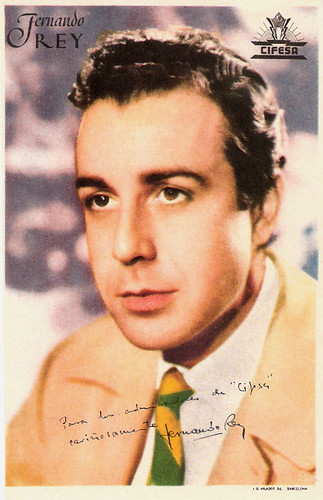
Fernando Rey. Spanish collectors card by I.G. Viladot, Barcelona. Image: Cifesa.

Paola Barbara. Spanish collectors card by I.G. Viladot, Barcelona. Image: Cifesa.
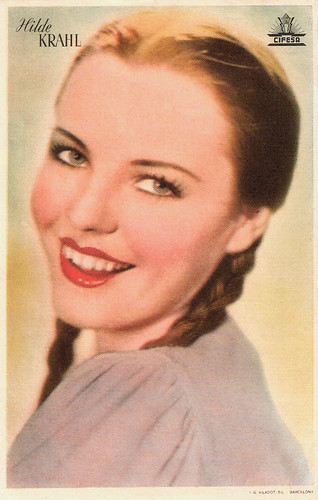
Hilde Krahl. Spanish collectors card by I.G. Viladot, Barcelona. Image: Cifesa.

Luis Peña. Spanish collectors card by I.G. Viladot, Barcelona. Image: Cifesa.

Carla Candiani. Spanish collectors card by I.G. Viladot, Barcelona. Image: Cifesa.

Viviane Romance. Spanish collectors card by I.G. Viladot, Barcelona. Image: Cifesa.

Fosco Giachetti. Spanish collectors card by V. Mari, Barcelona. Image: Cifesa.
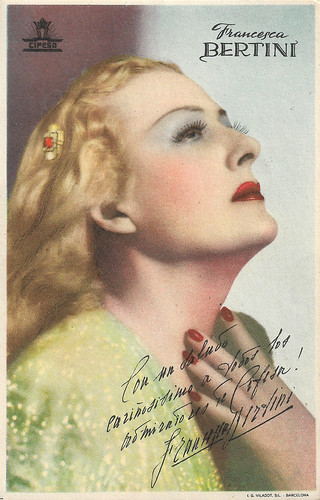
Francesca Bertini. Spanish collectors card by I.G. Viladot, Barcelona. Image: Cifesa.
Sources: Alberto Mira (Historical Dictionary of Spanish Cinema), A Companion to Spanish Cinema, Spanish popular cinema, 100 Years of Spanish Cinema, Wikipedia (Spanish and English) and IMDb.
This post was last updated on 28 May 2020.
Cifesa was the most important Spanish film production company and film distributor of the Franco era, and the only one that attempted to function as a traditional Hollywood studio. Among the stars of the studio were Luis Pena, Sara Montiel, Fernando Rey, Jorge Mistral, and the immensely popular Imperio Argentina. Cifesa sponsored lavish public premieres for selected films and created these star cards.

Sara Montiel. Spanish collectors card by I.G. Viladot, Barcelona. Image: Cifesa.

Alida Valli. Spanish collectors card by I.G. Viladot, Barcelona. Image: Cifesa.

Florencia Becquer. Spanish collectors card by I.G. Viladot, Barcelona. Image: Cifesa.

Luisa Ferida. Spanish collectors card by I.G. Viladot, Barcelona. Image: Cifesa.

Maria Mercader. Spanish collectors card by I.G. Viladot, Barcelona. Image: Cifesa.
The Torch of Hits
Cifesa, anacronym for Compania Industrial Film Espanola, was founded by Vicente Trenor in Valencia in 1932.
Soon it was soon taken over by an olive oil industrialist, Vicente Casanova, whose son had shown interest in the cinema. From 1933, the company turned out a series of well-crafted, expensive costume pictures and musicals directed by established figures like Benito Perojo and Florián Rey, and acquired a solid reputation among audiences.
Cifesa's motto was ‘The torch of hits’; creating a logo and a house style, as well as nurturing a compact group of stars, was an important lesson Casanova learned from Hollywood.
Ideologically, the Casanova family were conservative Republicans, but after the Civil War, the company pledged allegiance to the Franco regime. This was a perfect collaboration, as the studio was used for propaganda purposes and benefited from a series of privileges.
From 1942 on, against a background of absolute poverty in a country that would take two decades to recover from the conflict, Casanova was back in business producing a series of war films, melodramas, and comedies that created their own version of reality and refused to engage with social issues.
The studio-like aspects of the company were reinforced: soundstages and a company of actors (for instance Amparo Rivelles, Alfredo Mayo, and, later, Aurora Bautista) and technicians, and a certain consistency in tone and approaches due to the presence of strong directors (like Juan de Orduña and José Luis Sáenz de Heredia) who undertook their projects following general programs and guidelines and the firm grip of the head of the production Luis Lucia.
The general production standards were as high as the times allowed, but the emphasis was on high turnout rather than expensive individual films.

David Niven. Spanish collectors card by I.G. Viladot, Barcelona. Image: Cifesa.

Amedeo Nazzari. Spanish collectors card by I.G. Viladot, Barcelona. Image: Cifesa.

Rossano Brazzi. Spanish collectors card by I.G. Viladot, Barcelona. Image: Cifesa.

Willi Forst. Spanish collectors card by I.G. Viladot, Barcelona. Image: Cifesa.

Vittorio De Sica. Spanish collectors card by I.G. Viladot, Barcelona. Image: Cifesa.
Holding up the regime's conservative values
The end of World War II was a blow to the Franco government, which was plunged into a situation of complete isolation as the last remnant in Europe of Fascist ideologies. But rather than compromise and benefit from the reconstruction measures introduced by the Allies, the regime decided to strengthen conservatism.
The crisis this led to was reflected in the film business. The government redesigned the system of funding cultural expression - as long as it was the 'right' one. An important aspect was the introduction of a category of special support to those films that could uphold the regime's conservative values.
Casanova responded with a series of lavish historical epics. The company's strategy shifted now to focus on a small number of expensive pictures every year, which would not only be awarded 'special interest' funding but could also turn good profits at the box office.
In the beginning, the strategy seemed to work, with Locura de amor/Mad for Love (Juan De Orduña, 1948) and, later, Agustina de Aragón (Juan de Orduña, 1950), quickly becoming box-office hits.
But investment in each picture was so high that disappointing box-office takings could easily have an impact on the company's finances. This is exactly what happened with La leona de castilla/Lioness of Castille (Juan de Orduña, 1951).
When one of Cifesa's most expensive production efforts, an epic about Christopher Columbus' first expedition titled Alba de América/Dawn of America (Juan de Orduña, 1951), failed to get special interest funding because politicians decided to support José Antonio Nieves Conde's realistic Surcos/Burrows (1951) instead; and when the film only did average business, the company was back in the red, and this time it was unable to regain its previous prowess.
By 1952, the financial crisis deepened, and after a run of poor films, Cifesa disappeared as a film production company in 1956. As a distributor, Cifesa remained active till 1964.

Jean Harlow. Spanish collectors card by I.G. Viladot, Barcelona. Photo: Metro-Goldwyn Mayer. Was Cifesa perhaps the distributor?

Fernando Rey. Spanish collectors card by I.G. Viladot, Barcelona. Image: Cifesa.

Paola Barbara. Spanish collectors card by I.G. Viladot, Barcelona. Image: Cifesa.

Hilde Krahl. Spanish collectors card by I.G. Viladot, Barcelona. Image: Cifesa.

Luis Peña. Spanish collectors card by I.G. Viladot, Barcelona. Image: Cifesa.

Carla Candiani. Spanish collectors card by I.G. Viladot, Barcelona. Image: Cifesa.

Viviane Romance. Spanish collectors card by I.G. Viladot, Barcelona. Image: Cifesa.

Fosco Giachetti. Spanish collectors card by V. Mari, Barcelona. Image: Cifesa.

Francesca Bertini. Spanish collectors card by I.G. Viladot, Barcelona. Image: Cifesa.
Sources: Alberto Mira (Historical Dictionary of Spanish Cinema), A Companion to Spanish Cinema, Spanish popular cinema, 100 Years of Spanish Cinema, Wikipedia (Spanish and English) and IMDb.
This post was last updated on 28 May 2020.
No comments:
Post a Comment